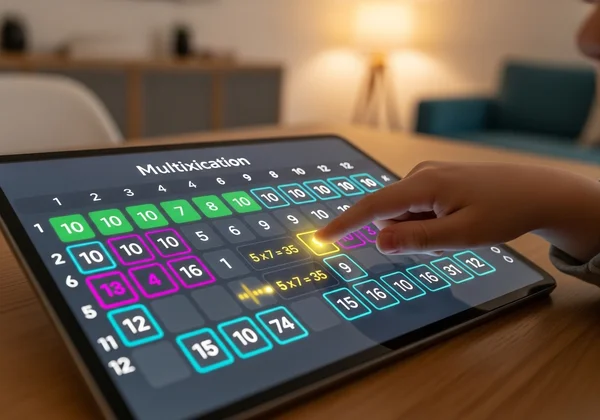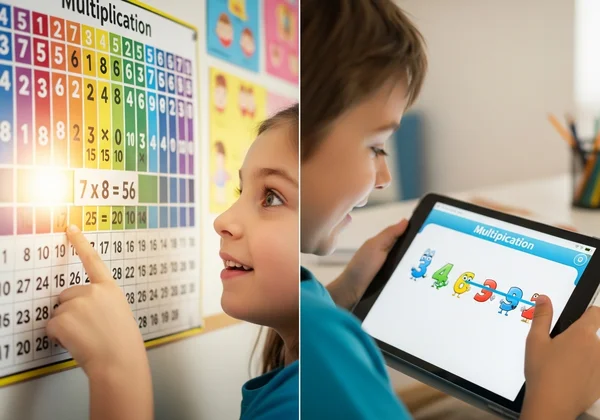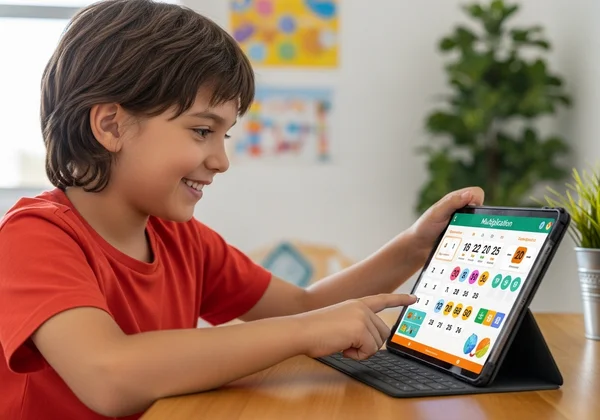Multiplication Chart vs. Flashcards: Best Learning Method?
Choosing the right tool to help your child learn multiplication can feel overwhelming. With so many options available, from traditional flashcards to modern digital apps, it's hard to know what will truly click. As parents and educators, we all want the same thing: to see our children not just memorize facts, but genuinely understand and feel confident in their math skills. What are the easiest ways to learn multiplication? This guide will compare two of the most popular methods—the time-tested flashcard and the dynamic, interactive multiplication chart—to help you discover which approach best supports your child's journey to math mastery.
Understanding Flashcards: Rote Memorization's Role in Learning Multiplication
For generations, flashcards have been the go-to tool for drilling math facts. They are simple, portable, and focus on one core principle: repetition. The idea is that by repeatedly seeing a problem (e.g., 7 x 8) and its answer (56), the information will eventually move from short-term to long-term memory. This method is rooted in the concept of rote memorization.
The Benefits of Traditional Flashcard Drills
There's no denying that flashcards have their place in the learning toolkit. One of their main advantages is speed. They are excellent for quick-fire drills that build recall speed, which is essential for timed tests and more complex math problems down the road. This focus on rote memorization can be effective for children who learn well through repetition and need to solidify individual multiplication facts quickly. They are also screen-free, which many parents appreciate as a way to reduce digital distractions during homework time.
Where Flashcards Fall Short: Common Challenges with Rote Learning
However, the singular focus on memorization is also the biggest drawback of flashcards. This method often bypasses a deeper conceptual understanding. A child might know that 6 x 7 = 42, but do they understand why? Flashcards don't illustrate the relationships between numbers or reveal the beautiful patterns hidden within multiplication. This can lead to a fragmented understanding of math, where facts are isolated islands of information rather than part of an interconnected system. For many children, this repetitive drilling can also become monotonous and lead to disengagement or even math anxiety.

Exploring the Interactive Multiplication Chart: A Modern Visual Approach
In contrast to the one-problem-at-a-time nature of flashcards, an interactive multiplication chart presents all the facts within a grid. This visual format provides context and allows children to see the bigger picture. Modern tools, like the interactive multiplication table available on our site, take this a step further by adding layers of interactivity that transform a static grid into a dynamic learning playground.
How Interactive Charts Promote Pattern Recognition and Understanding
The human brain is wired to recognize patterns, and a multiplication chart is a treasure trove of them. An interactive grid makes discovering these patterns an engaging activity. For example, by using the color-highlighting feature on an interactive times table, a child can instantly see that all the multiples of 10 end in 0, or they can visualize the diagonal line of square numbers (1, 4, 9, 16...). This process of pattern recognition helps children build a mental map of how numbers relate to one another, which is far more powerful than memorizing facts in isolation.
Beyond Memorization: Engagement and Customization in Digital Charts
Interactivity is the key to keeping young learners engaged. Instead of passively flipping cards, children can actively explore the chart. Hovering over a number to see the corresponding equation instantly gratifies curiosity. This active participation makes learning feel less like a chore and more like a game. These online multiplication tools often bridge the gap between static learning and fun multiplication games, offering a perfect balance. This engagement fosters a positive attitude toward math and empowers children to take control of their own learning process.

Matching the Method to Your Child's Learning Style
Ultimately, the "best" learning method depends heavily on the individual child. Understanding your child's natural learning style can help you choose the most effective tools. Answering the question, "How can I help my child learn multiplication?" often starts with observing how they learn best in other areas.
Is Your Child a Visual or Kinesthetic Learner for Math?
If your child is a visual learning enthusiast who loves drawing, puzzles, and seeing how things fit together, a multiplication chart is a natural fit. The grid layout, colors, and patterns will appeal directly to their strengths. A kinesthetic learner, who learns best by doing, also benefits immensely from an interactive chart. The act of clicking, hovering, and coloring in squares provides the hands-on engagement they crave, making abstract concepts feel tangible and real. You can explore this with our hands-on learning tool.

When to Combine Methods for Maximum Impact
The debate doesn't have to be "either/or." A blended approach can often yield the best results. You can use an interactive chart to build foundational understanding and discover patterns, then supplement with a printable multiplication chart for offline practice. Once a child understands the "why" behind the facts, flashcards can be used in short, fun bursts to increase their recall speed. The goal is to create a rich and varied learning environment that caters to different needs at different stages.
Why Visual & Interactive Tools Lead to Deeper Multiplication Mastery
While flashcards focus on the "what" (the answer), interactive charts illuminate the "how" and "why." This deeper level of understanding is crucial for long-term success in mathematics. When children see the logic and patterns behind the facts, they are not just memorizing; they are building number sense.
Building Confidence and Reducing Math Anxiety with Engaging Tools
One of the most significant benefits of using engaging tools is their impact on a child's confidence. When learning feels like discovery and play, the fear of getting an answer wrong diminishes. Interactive charts provide a safe space to explore without pressure. This positive experience helps prevent math anxiety and nurtures a lifelong curiosity for numbers. A child who feels confident is more likely to persevere through challenging problems and view math as a skill they can master.
Practical Application: Using the Interactive Multiplication Chart for Hands-On Learning
Putting this into practice is simple and effective. Guide your child to our free interactive multiplication table. Encourage them to move the mouse over different squares and watch as the multiplication problem and its answer appear. Ask them to use the color palette to mark all the multiples of 5. Or challenge them to find all the instances of the number 24 on the grid. This simple, hands-on exploration transforms abstract numbers into a concrete, visual, and memorable experience.

Empowering Your Child's Multiplication Journey
When considering multiplication charts versus flashcards, it becomes clear that while flashcards have their place for quick recall, the interactive multiplication chart offers a superior path to building a deep, lasting, and intuitive understanding. By choosing tools that align with how children naturally learn, we can transform multiplication from a daunting memorization task into an exciting journey of discovery. Ready to see the difference for yourself? Explore our free tool today and watch your child build the confidence and skills they need to succeed.
Frequently Asked Questions About Multiplication Learning Methods
What are the key differences between multiplication charts and flashcards?
The main difference is context. Flashcards present multiplication facts in isolation, focusing on rote memorization. Multiplication charts show all the facts in a grid, which helps children see patterns, understand number relationships, and build a deeper conceptual understanding.
How can I identify my child's learning style for multiplication?
Observe your child. Do they remember things better when they see them written down (visual)? Do they need to move around and physically interact with things to learn (kinesthetic)? Visual learners thrive with charts and colors, while kinesthetic learners love the interactivity of our online tool.
Are interactive multiplication charts truly more effective than traditional methods?
For building foundational understanding and long-term retention, yes. Interactive charts engage multiple learning pathways, reduce math anxiety, and make learning fun. This leads to better comprehension and confidence, which traditional drill-and-practice methods often fail to foster.
What's the easiest way to learn multiplication facts using a chart?
Start by exploring one number set at a time (e.g., the 2s, 5s, and 10s tables). Use the color-highlighting feature on an interactive chart to mark these multiples and discuss the patterns you see. This visual connection makes the facts much easier to remember.
How can the Interactive Multiplication Chart help my child master multiplication?
Our website offers a free, highly interactive multiplication table that makes learning visual and fun. With features like hover-to-reveal answers and color highlighting, children can explore number patterns at their own pace. We also provide printable charts for offline practice, creating a complete and effective learning system to help your child master multiplication.